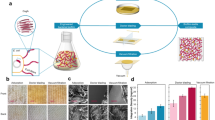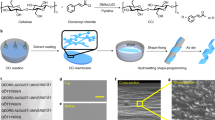Abstract
Petrochemical-based plastics have not only contaminated all parts of the globe, but are also causing potentially irreversible damage to our ecosystem because of their non-biodegradability. As bioplastics are limited in number, there is an urgent need to design and develop more biodegradable alternatives to mitigate the plastic menace. In this regard, we report aquaplastic, a new class of microbial biofilm-based biodegradable bioplastic that is water-processable, robust, templatable and coatable. Here, Escherichia coli was genetically engineered to produce protein-based hydrogels, which are cast and dried under ambient conditions to produce aquaplastic, which can withstand strong acid/base and organic solvents. In addition, aquaplastic can be healed and welded to form three-dimensional architectures using water. The combination of straightforward microbial fabrication, water processability and biodegradability makes aquaplastic a unique material worthy of further exploration for packaging and coating applications.

This is a preview of subscription content, access via your institution
Access options
Access Nature and 54 other Nature Portfolio journals
Get Nature+, our best-value online-access subscription
$29.99 / 30 days
cancel any time
Subscribe to this journal
Receive 12 print issues and online access
$259.00 per year
only $21.58 per issue
Buy this article
- Purchase on Springer Link
- Instant access to full article PDF
Prices may be subject to local taxes which are calculated during checkout




Similar content being viewed by others
Data availability
All relevant data supporting the findings of this study and the plasmids and strains used are available within the Article and its Supplementary Information or from the corresponding authors upon request. Source data are provided with this paper.
References
Khalil, A. S. & Collins, J. J. Synthetic biology: applications come of age. Nat. Rev. Genet. 11, 367–379 (2010).
Nguyen, P. Q., Courchesne, N. D., Duraj-Thatte, A., Praveschotinunt, P. & Joshi, N. S. Engineered living materials: prospects and challenges for using biological systems to direct the assembly of smart materials. Adv. Mater. 30, e1704847 (2018).
Chen, A. Y., Zhong, C. & Lu, T. K. Engineering living functional materials. ACS Synth. Biol. 4, 8–11 (2015).
Gilbert, C. & Ellis, T. Biological engineered living materials: growing functional materials with genetically programmable properties. ACS Synth. Biol. 8, 1–15 (2019).
Duraj-Thatte, A. M. et al. Genetically programmable self-regenerating bacterial hydrogels. Adv. Mater. 31, e1901826 (2019).
Botyanszki, Z., Tay, P. K., Nguyen, P. Q., Nussbaumer, M. G. & Joshi, N. S. Engineered catalytic biofilms: site-specific enzyme immobilization onto E. coli curli nanofibers. Biotechnol. Bioeng. 112, 2016–2024 (2015).
Nguyen, P. Q., Botyanszki, Z., Tay, P. K. & Joshi, N. S. Programmable biofilm-based materials from engineered curli nanofibres. Nat. Commun. 5, 4945 (2014).
Chen, A. Y. et al. Synthesis and patterning of tunable multiscale materials with engineered cells. Nat. Mater. 13, 515–523 (2014).
Zhong, C. et al. Strong underwater adhesives made by self-assembling multi-protein nanofibres. Nat. Nanotechnol. 9, 858–866 (2014).
Gonzalez, L. M., Mukhitov, N. & Voigt, C. A. Resilient living materials built by printing bacterial spores. Nat. Chem. Biol. 16, 126–133 (2020).
Tay, P. K. R., Manjula-Basavanna, A. & Joshi, N. S. Repurposing bacterial extracellular matrix for selective and differential abstraction of rare earth elements. Green Chem. 20, 3512–3520 (2018).
Liu, X. et al. Stretchable living materials and devices with hydrogel–elastomer hybrids hosting programmed cells. Proc. Natl Acad. Sci. USA 114, 2200–2205 (2017).
Geyer, R., Jambeck, J. R. & Law, K. L. Production, use and fate of all plastics ever made. Sci. Adv. 3, e1700782 (2017).
Chiellini, E., Corti, A., D’Antone, S. & Solaro, R. Biodegradation of poly (vinyl alcohol) based materials. Prog. Polym. Sci. 28, 963–1014 (2003).
Flemming, H. C. & Wingender, J. The biofilm matrix. Nat. Rev. Microbiol. 8, 623–633 (2010).
Barnhart, M. M. & Chapman, M. R. Curli biogenesis and function. Annu. Rev. Microbiol. 60, 131–147 (2006).
Nussbaumer, M. G. et al. Bootstrapped biocatalysis: biofilm-derived materials as reversibly functionalizable multienzyme surfaces. ChemCatChem 9, 4328–4333 (2017).
Duraj-Thatte, A. M., Praveschotinunt, P., Nash, T. R., Ward, F. R. & Joshi, N. S. Modulating bacterial and gut mucosal interactions with engineered biofilm matrix proteins. Sci. Rep. 8, 3475 (2018).
Wu, X. et al. Sodium dodecyl sulfate-induced rapid gelation of silk fibroin. Acta Biomater. 8, 2185–2192 (2012).
Wei, G. et al. Self-assembling peptide and protein amyloids: from structure to tailored function in nanotechnology. Chem. Soc. Rev. 46, 4661–4708 (2017).
Adamcik, J. et al. Measurement of intrinsic properties of amyloid fibrils by the peak force QNM method. Nanoscale 4, 4426–4429 (2012).
Avinash, M. B., Raut, D., Mishra, M. K., Ramamurty, U. & Govindaraju, T. Bioinspired reductionistic peptide engineering for exceptional mechanical properties. Sci. Rep. 5, 16070 (2015).
Phan, D. C., Goodwin, D. G. Jr, Frank, B. P., Bouwer, E. J. & Fairbrother, D. H. Biodegradability of carbon nanotube/polymer nanocomposites under aerobic mixed culture conditions. Sci. Total Environ. 639, 804–814 (2018).
Knowles, T. P. & Mezzenga, R. Amyloid fibrils as building blocks for natural and artificial functional materials. Adv. Mater. 28, 6546–6561 (2016).
Du, Z. et al. The review of powder coatings. Chem. Mater. Sci. 4, 54–59 (2016).
Avinash, M. B., Verheggen, E., Schmuck, C. & Govindaraju, T. Self-cleaning functional molecular materials. Angew. Chem. Int. Ed. 51, 10324–10328 (2012).
Albertsson, A. C. & Hakkarainen, M. Designed to degrade. Science 358, 872–873 (2017).
Abdullah, Z. W., Dong, Y., Davies, I. J. & Barbhuiya, S. PVA, PVA blends, and their nanocomposites for biodegradable packaging application. Polym. Plast. Technol. Eng. 56, 1307–1344 (2017).
Amsden, J. J. et al. Rapid nanoimprinting of silk fibroin films for biophotonic applications. Adv. Mater. 22, 1746–1749 (2010).
Kim, D. H. et al. Dissolvable films of silk fibroin for ultrathin conformal bio-integrated electronics. Nat. Mater. 9, 511–517 (2010).
Perry, H., Gopinath, A., Kaplan, D. L., Dal Negro, L. & Omenetto, F. Nano‐ and micropatterning of optically transparent, mechanically robust, biocompatible silk fibroin films. Adv. Mater. 20, 3070–3072 (2008).
Brenckle, M. et al. Methods and applications of multilayer silk fibroin laminates based on spatially controlled welding in protein films. Adv. Funct. Mater. 26, 44–50 (2015).
Moreau, D., Chauvet, C., Etienne, F., Rannou, F. P. & Corte, L. Hydrogel films and coatings by swelling-induced gelation. Proc. Natl Acad. Sci. USA 113, 13295–13300 (2016).
Fernandez, J. G. & Ingber, D. E. Manufacturing of large-scale functional objects using biodegradable chitosan bioplastic. Macromol. Mater. Eng. 299, 932–938 (2014).
Guo, C. et al. Thermoplastic moulding of regenerated silk. Nat. Mater. 19, 102–108 (2020).
Latza, V. et al. Multi-scale thermal stability of a hard thermoplastic protein-based material. Nat. Commun. 6, 8313 (2015).
Beguin, P. & Aubert, J. P. The biological degradation of cellulose. FEMS Microbiol. Rev. 13, 25–58 (1994).
Acknowledgements
Work was performed in part at the Center for Nanoscale Systems at Harvard. Work in the N.S.J. laboratory is supported by the National Institutes of Health (1R01DK110770, N.S.J.), the National Science Foundation (DMR 2004875, N.S.J.) and the Wyss Institute for Biologically Inspired Engineering at Harvard University. Parts of the schematics were adapted from BioRender.com.
Author information
Authors and Affiliations
Contributions
A.M.D.-T. and A.M.-B. conceived the idea. A.M.D.-T. and A.M.-B. prepared aquagels, fabricated aquaplastics, tested the chemical resistance of the aquaplastic, performed aquaplastic coating, templating and rehydration studies as well as aqua-healing and aqua-welding. A.M.-B. performed FESEM and nanoindentation studies. N.-M.D.C. and G.I.C. performed initial experiments with aquagels and aquaplastic. A.S.-F. carried out WAXS and DSC studies. L.v.H. performed TGA and DSC studies. B.P.F. performed biodegradation studies. S.K.C. performed tensile tests. D.H.F. supervised B.P.F. R.M. supervised A.S.-F. and L.v.H. A.M.D.-T., A.M.-B. and N.S.J. wrote and/or edited the manuscript. All authors discussed and commented on the manuscript.
Corresponding author
Ethics declarations
Competing interests
A.M.D.-T., N.-M.D.C. and N.S.J. are inventors on patent application WO2017201428A8, submitted by Harvard University.
Additional information
Publisher’s note Springer Nature remains neutral with regard to jurisdictional claims in published maps and institutional affiliations.
Extended data
Extended Data Fig. 1 Coating of curli aquaplastic on various surfaces.
Coating of curli aquaplastic on various surfaces. Optical images of a. Cow leather, b. Plywood c. Mobile phone touch screen, d. Aluminum automobile exterior body part and e. Copper wire coated with curli aquaplastic. FESEM images of coated and uncoated surfaces are shown below.
Supplementary information
Supplementary Information
Supplementary Figs. 1–17 and Tables 1 and 2.
Source data
Source Data Fig. 2
Raw data.
Source Data Fig. 4
Raw data.
Rights and permissions
About this article
Cite this article
Duraj-Thatte, A.M., Manjula-Basavanna, A., Courchesne, NM.D. et al. Water-processable, biodegradable and coatable aquaplastic from engineered biofilms. Nat Chem Biol 17, 732–738 (2021). https://doi.org/10.1038/s41589-021-00773-y
Received:
Accepted:
Published:
Issue Date:
DOI: https://doi.org/10.1038/s41589-021-00773-y
This article is cited by
-
Structural engineered living materials
Nano Research (2024)
-
Phenotypically complex living materials containing engineered cyanobacteria
Nature Communications (2023)
-
Fluid protein condensates for bio-inspired applications
Nature Reviews Bioengineering (2023)
-
Recastable assemblies of carbon dots into mechanically robust macroscopic materials
Nature Communications (2023)
-
Endowing textiles with self-repairing ability through the fabrication of composites with a bacterial biofilm
Scientific Reports (2023)



